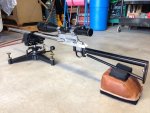So long as you don't distort the stock as your casting your bedding or tweak the action, chances are it'll run just fine."
Is it narcissistic to quote yourself?

Here's the ticket gents. I once watched and employee dote over a bedding job on a Nesika years ago. Prep work was perfect, mixed the resin, etc. Lays it all up and then grabs a big ol wood working clamp and squashes the action into the stock. I could visually see (from 10 feet back) that he was distorting the stock as the action pulled up on the pillar registers.
I decided to use it as an exercise so I kept my mouth shut. Next day we pop the thing out and it looks great. Then we got out the indicators and started checking stuff. The stock was out about .008" across its mid length between front/rear guard screw holes.
So, the lesson here is you have to think this stuff through a little bit. It's not rocket science, but there is some common sense involved. I turn to high performance engine building for guidance. Torque plates have been around now for decades. They simulate the distortion to a cylinder case created when the heads are bolted on. The better equipped shops have gone so far as to circulate hot water/oil through the engine blocks as the cylinders are being honed. The whole purpose being attempting to replicate the conditions the engine case will experience when assembled and running. -make the holes round and free of taper under the conditions the materials experience while its running.
Using this as our inspiration, I encourage those who like to take on this kind of work to begin exploring things along these lines. IF an action truly does distort from a 8lb barrel hanging off it, then maybe we need to ensure that we bed the receiver in such a manner that this "stress" is accurately cast into the resin. More importantly, IF it does, find out if it effects anything. I think we already have that answer, but in the interest of avoiding a nasty internet battle I'm going to dodge the specifics.
IF a guard screw causes a material deflection around the circumference of the hole where it screws into it, then maybe it'd be beneficial to ensure we torque the screws when bedding as we would when assembled. This way the casting accurately mirrors this distortion.
And finally, while your doing all this keep in mind that the best, most precise, sexiest bedding job in the world won't solve a barrel issue. It just won't.
When your bedding a gun, a scope base, lapping lugs, tuning loads, etc your searching for that last mystical 15-20 hp that a pro stock team spends millions looking for each season. If they have a turd for an engine, then its a waste of time.
Good luck.
C.




